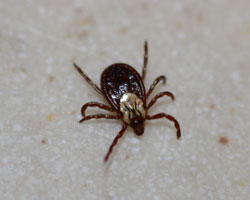They’re creepy, they’re crawly, so be on the lookout for ticks
A hard tick called the American dog tick is the most commonly reported species in Kansas.
 Photos and captions available
Photos and captions available
Released: June 6, 2016
MANHATTAN, Kan. – They’re tiny and slow moving, and this spring’s cool, humid weather across the central Plains has been to their liking, so Kansas State University entomologists are encouraging anyone spending time outdoors to be on the lookout for ticks.
Typically found in undisturbed grasses, weeds and other overgrown vegetation, ticks have even been found this year in corn fields, which is unusual because tillage practices in corn fields usually destroy eggs and young ticks, according to Kansas State University entomologist Jeff Whitworth.
The American dog tick (Dermacentor variabilis) has benefited from this spring’s cool, wet weather, Whitworth said. Other types commonly found in Kansas are the lone star tick (Amblyomma americanum) and blacklegged tick or deer tick (Ixodes scapularis). All three are hard ticks, characterized by a hardened shell and a head that extends in front of the body.
The wingless parasites, which feed exclusively on human and animal blood, can carry dangerous microbial pathogens and are difficult to control for several reasons.
They make babies – a lot of them. After mating, the adult female American dog tick feeds on her human or animal host until engorged, then drops off and deposits eggs in the environment, Whitworth said. She dies after she deposits her eggs, but those egg masses typically number in the thousands from just one female. Males feed sparingly and do not engorge.
There are multiple tick species, and they can live up to two years, plus they can feed on numerous wildlife or human hosts.
Ticks are most commonly found just a few inches or feet off the ground on vegetation and typically ambush their human or animal “hosts,” as they look for a meal by crawling onto grass, weeds, or low bushes and waiting for a host to brush against the vegetation. They then move onto the host to look for a site to attach and feed. Ticks do not jump or drop from trees, Whitworth said.
If not engorged, American dog ticks are typically only about one-eighth of an inch long. If engorged, they increase in size up to three-quarters of an inch.
American dog ticks are common throughout Kansas, especially in grasslands and along the edge of forests. They can transmit Rocky Mountain Spotted Fever, a potentially fatal illness to dogs, cats, and humans, and Cytauxzoonosis, an often-fatal blood parasite to cats. They can also cause tick paralysis.
Lone star ticks are most commonly found in woodland habitats with dense underbrush. White-tailed deer and wild turkeys are considered prominent hosts for these ticks, but other animals also serve as hosts. They can transmit human monocytic ehrlichiosis. They can also transmit Tularemia, which causes a Lyme disease-like infection called Southern tick-associated rash illness.
Black-legged ticks are also known as the deer tick or Lyme disease tick. Their primary host is the white-tailed deer. These ticks carry Lyme disease in the central and eastern United States. Typical symptoms of Lyme disease include fever, headache, fatigue and a characteristic skin rash called erythema migrans, according to the Centers for Disease Control and Prevention. If left untreated, infection can spread to joints, the heart and the nervous system.
Avoidance and removal
To protect against ticks, avoid going into tall grass, weeds and brushy areas, Whitworth said. For those who do go into such areas, light-colored clothing can help you see ticks before they reach the skin. Repellents based on DEET (N,N diethyl-meta-toluamide) and permethrin work well in keeping ticks and mosquitoes away. Permethrin-based repellents must not be applied directly to skin.
After coming home from potentially tick-infested areas, inspect your skin, and remove ticks immediately. Ticks removed within several hours after attachment are unlikely to transmit pathogens, Whitworth said.
If a tick has already attached itself, remove it manually by grasping as close to the skin as possible with forceps or tweezers, and pull straight away from the skin, using slow, steady pressure. The tick should not be twisted or jerked out, as that increases the chance for its head to be left in the skin. Do not use a lighted match or cover the tick in petroleum jelly or nail polish.
Ticks removed from people should be saved in a vial with alcohol and labeled with the date. If flu-like symptoms, such as headache, skin rash and fever occur 10 to 14 days after the tick’s removal, see a physician immediately, and take the tick with you. If in Kansas, send it to the local K-State Research and Extension office.
Prevention and control
Clip grassy and weedy areas around the house short to expose ticks to sunlight and subsequent desiccation. Spring burning of grasslands reduces the tick and rodent (tick host) populations temporarily.
Chemical pesticides targeting ticks and mites are called acaricides. They should be used only in areas with chronic tick problems.
More information about ticks in Kansas is available through a Kansas State University publication available online.
-30-
K‑State Research and Extension is a short name for the Kansas State University Agricultural Experiment Station and Cooperative Extension Service, a program designed to generate and distribute useful knowledge for the well‑being of Kansans. Supported by county, state, federal and private funds, the program has county Extension offices, experiment fields, area Extension offices and regional research centers statewide. Its headquarters is on the K‑State campus in Manhattan.
Story by:
Mary Lou Peter
mlpeter@ksu.edu
K-State Research and Extension
For more information:
Jeff Whitworth - 785-532-5656 or jwhitwor@ksu.edu
